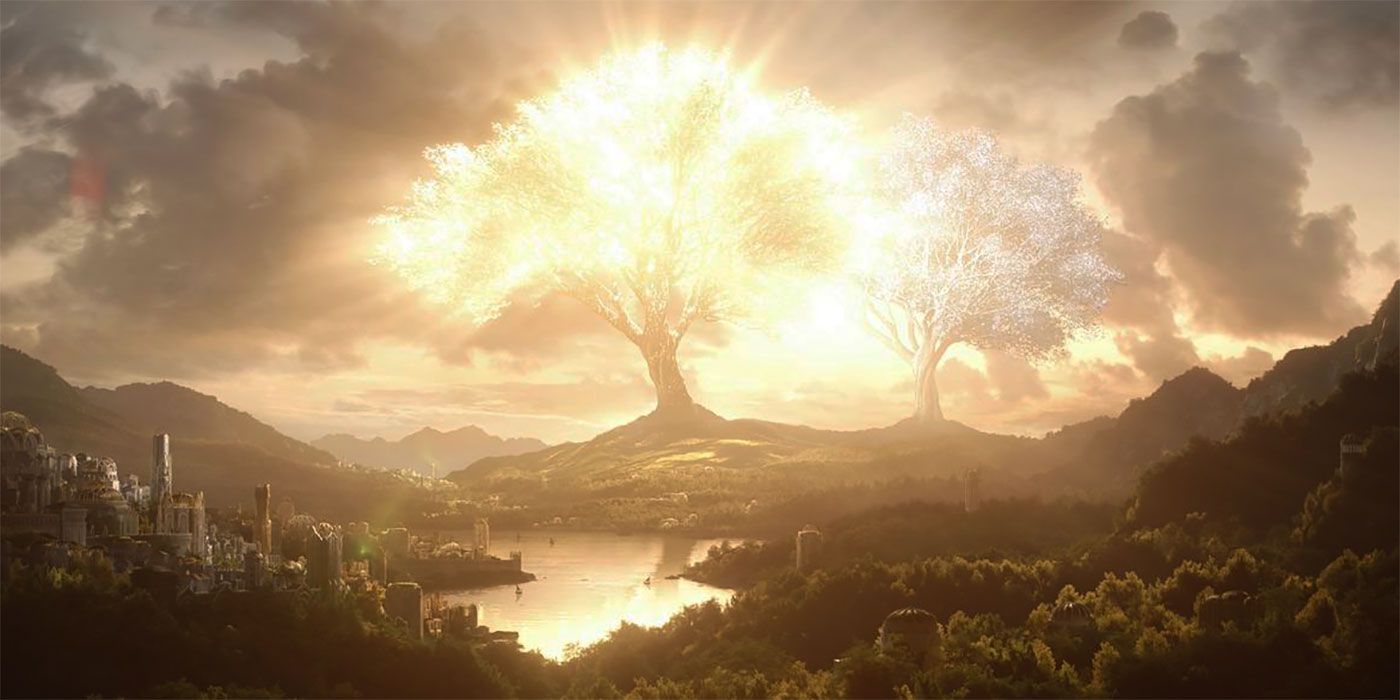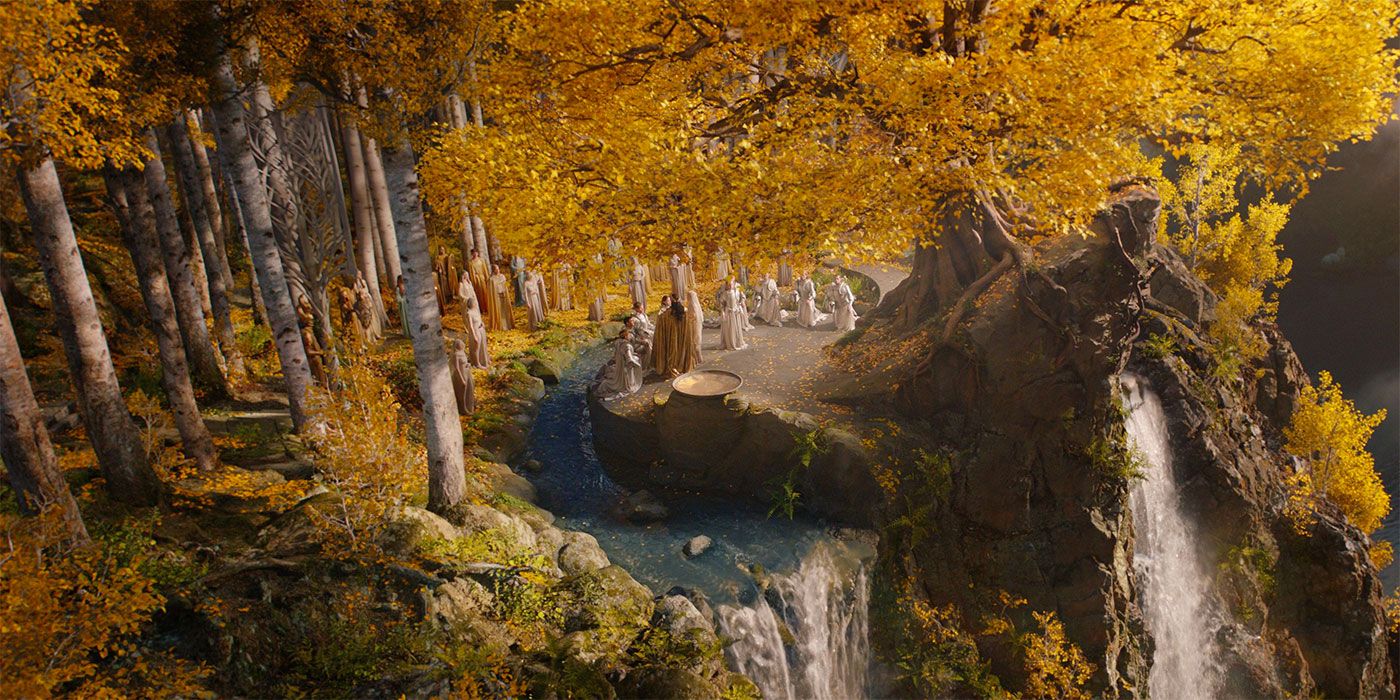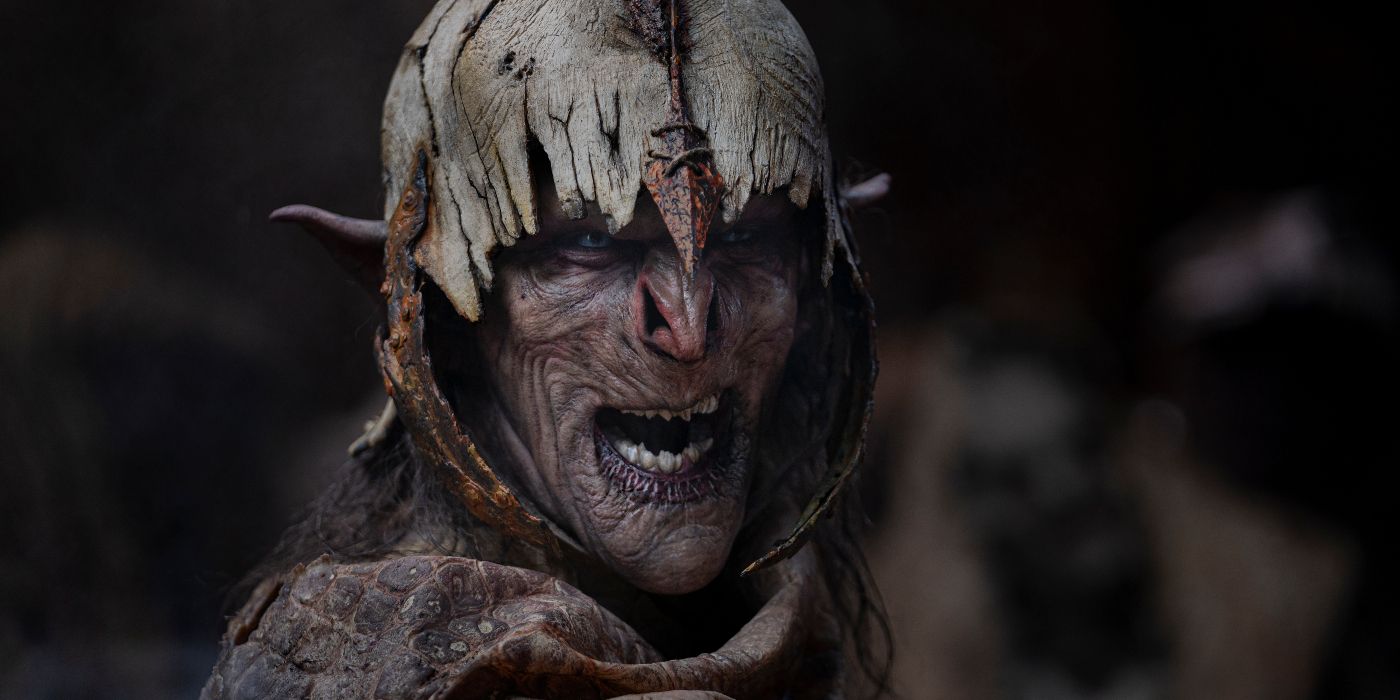Editor's note: The below article contains spoilers for Episode 1 of The Lord of the Rings: The Rings of Power.
While The Lord of the Rings: The Rings of Power takes place in the Second Age of Arda, the world created by J.R.R. Tolkien, the first episode of the show gives us a glimpse of the wonders and horrors of the First Age. By focusing on the childhood of Galadriel (Amelie Child Villiers), The Rings of Power gives us a taste of Valinor, the land of the Valar, the divinities who shaped the world and who still reside in the lost continent far West of Middle-earth. In the flashback, we can see two giant trees, one golden and one silver, shining bright and spreading their light over the land. The Tree’s decaying is also revealed to be caused by Morgoth, the First Dark Lord, and symbolizes the moment where Elves departed from Valinor and went to war in Middle-earth.
While it’s thrilling for fans of Tolkien's literary work to see Valinor come to life, people who only watched the movies developed by Peter Jackson might feel a little lost with the information dump of The Rings of Power’s premiere. That is no surprise since the lore created by Tolkien is vast and filled with grand events long before the world ever heard of Frodo Baggins. So, now that The Rings of Powers is finally available on Prime Video, it’s time to discuss what exactly are the Trees of Valinor. Where did they come from? How did they die? And what’s their relation to the Sun and Moon?
Let There Be Light in Valinor
When the Valar first descended to Arda (the world of Middle-earth) and started to shape the world, they were followed by Melkor, a Vala who defied the will of Ilúvatar, the One God, and corrupted every work of beauty his siblings tried to build. At that time, the Valar decided to take residence in Middle-earth, and to lighten up the world, they built two giant lamps: Illuin, a silver lamp, was placed in the North of Middle-earth, while Ormal, the golden one, was placed in the South. There were no nights and days when Arda was created, as the only light available came from the stars and the two lamps.
During one of his first attacks, Melkor, who would later be renamed Morgoth, destroyed the lamps, spreading their fire through Middle-earth. Distressed by the evil things Melkor released into the world, the Valar left Middle-earth, forging a new kingdom in Aman, a continent to the West. The Valar lands were known as Valinor, a holy kingdom protected from all evil. But the memory of the lost lamps of Middle-earth caused sadness in the hearts of the Valar, which led to the creation of the Two Trees.
According to Tolkien’s lore, the Trees of Valinor came to life through a song sung by Yavanna, the Lady of the Earth, a Vala who loved the flora most of all things. They grew in Valinor thanks to the tears of Nienna, the Weeper, a Vala responsible for spreading mercy on Arda. And just like the lost lamps, each Tree of Valinor spread a bright light over the lands. The first Tree, Telperion, shone with silver light. As for Laurelin, the Tree shone in bright gold. Each Tree of Valinor was ensnared in an eternal cycle of flourishing and shining bright for seven hours and then slowly waning again. However, the two Trees took altered turns in their cycles. Therefore, Valinor started to count time by the passage of days, with each day lasting twelve hours. For a full hour at dusk and another full hour at dawn, both Trees were shining together, spreading both silver and gold light in the lands of the Valar.
Darkness Consumes All
When Melkor decided to unleash a new attack on the Valar, he enlisted the help of Ungoliant, an ancient being made of Darkness who had taken the shape of a monstrous spider. Ungoliant is the creator of every Giant Spider, including Shelob, who would appear in The Return of the King. Since Ungoliant is a manifestation of Darkness, it could devour light itself. So, when Melkor attacked Valinor, he pierced each husk with a spear, letting Ungoliant drain the sap of the Trees of Valinor, sucking out their lights and drying up their wood. Melkor and Ungoliant escaped to Middle-earth amidst the chaos, taking the Silmarils with them. And their vicious attack would also lead to the great Elven war against Morgoth. But the damage they caused was irreparable, and after the attack, both Trees of Valinor were destroyed.
Yavanna tried to revive the Trees of Valinor with her song, and Nienna used her tears to wet the soil beneath them. But even the power of the two Valar was not enough to bring Telperion and Laurelin back to life. However, their efforts were not in vain, as Telperion gave birth to one last flower, and Laurelin gave birth to one last fruit. To ensure the light of the Trees of Valinor would forever shine over Arda, the Valar decided to take this last flower and fruit to the skies in huge vessels created by Aulë, the Smith, one of the Valar.
And so, Telperion’s flower became the Moon, while Laurelin’s fruit became the Sun. Each light source is carried over the skies by a Maia, a kind of divinity that ranks below the Valar in Tolkien’s cosmology. The Sun is carried by Arien, a spirit of fire Melkor was unable to deceive and who gladly accepted the task of parading Laurelin’s fruit in the sky to spite the Enemy. As for the Moon, it is carried by Tilion, a faithful servant of Oromë, the Huntsman, one of the Vala who most despised Melkor.
Since Tolkien imagined Middle-earth as an ancient version of our own planet, the story of the Trees of Valinor explains why we have day and night cycles. So, every time you look at the skies, you can imagine Arien and Tilion guarding the Sun and the Moon while their vessels navigate the skies.
The first two episodes of The Lord of the Rings: The Rings of Power are streaming now on Prime Video. New episodes become available every Friday.



